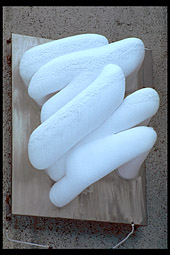
Differential circuit and voltage diagram for operating APD in Geiger mode
| Student: | Torbjoern Nesheim, Torbjoern.Nesheim@kongsberg.com |
| Supervisor: | Professor Dag Roar Hjelme |
| Delivered: | January 1999 |
Torbjoern started to develop the single photon detector, which is an important part of the quantum key distribution (QKD) channel.
This work was later followed by Kirill Vylegjanine's thesis that introduced afterpulse blocking technique, which lifted the limitation on gate pulse rate (repetition rate).

The objective of this thesis was to design and test a single photon detector, a part in a quantum cryptation experimental setup. Circuits and other mechanical arrangement were developed.
The physical properties of the avalanche photo diode (APD), which is the detection component in the system, are important to understand. The goal is to keep the dark count rate as low as possible. The APD, which was operated in the Geiger mode, was sensitive to several parameters. By some preliminary trials it was concluded that the gate width should be as narrow as possible to prevent dark counts. This would also make it possible to increase upper limit of the repetition rate. But a too high value of the repetition rate increases the dark count rate significantly due to a process called trapping.
Some models for evaluating the APD and the performance of the system were developed. A detector efficiency of 50% was achieved with an error rate of 0.5%. Better efficiencies were achieved at the cost of higher error rates, and reverse. Based on the detection efficiency models, the system performs better at low detector efficiencies and high repetition rates. But the model did not give an obvious optimal point, and the user should decide himself what properties are more important.
It was thought that raising the temperature above its normal level of 77K might have been advantageous, but no improvements were observed for this detector. The performance declined instead.
In this thesis the student will develop and test the performance of cooled and gated detector modules intended for use in a quantum cryptography experiment. Physical properties of the APD in gated mode will be investigated and related to the operational parameters of the system. This will lead to a model describing the optimized point of operation for single photon detection.
In Geiger mode, the reverse voltage on APD is kept just below the breakdown voltage level (typically

Our scheme uses differential circuit to cancel curent spikes flowing through the APD capacitance (few pF) at the rising and falling edges of the gating pulse. When it is properly tuned, i.e. when the length of transmission lines and the variable capacitor are adjusted to make the arms electrically identical in the absence of avalanches, there is no signal on the output. If an avalanche occurs, it produces a nice short pulse.
We tested few different APDs. The one we ended up using was Russian-made FD312L (Ge, 1300nm).
The APD is cooled down to reduce dark count rate. We used liquid nitrogen cooling (77K).
The output pulses are latched by a digital circuit, buffered in a high-speed memory and eventually read by Bob's computer in a QKD channel (but these are topics of later publications).
1If you are looking for a single-photon detector for 400nm to 1100nm wavelength range, PerkinElmer (formerly EG&G) makes a good one based on Si APDs. For longer wavelengths (down to 1.6um), check the detection modules from id Quantique and HIOKI. It's actually not very difficult to make one yourself, and it can even suit your application better. You may ask us.